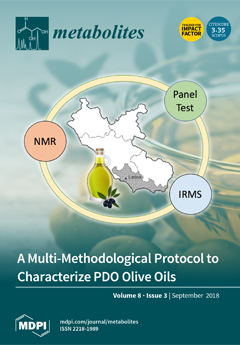The use of metabolomics profiling to understand the metabolism under different physiological states has increased in recent years, which created the need for robust analytical platforms. Here, we present a validated method for targeted and semiquantitative analysis of 102 polar metabolites that cover
[...] Read more.
The use of metabolomics profiling to understand the metabolism under different physiological states has increased in recent years, which created the need for robust analytical platforms. Here, we present a validated method for targeted and semiquantitative analysis of 102 polar metabolites that cover major metabolic pathways from 24 classes in a single 17.5-min assay. The method has been optimized for a wide range of biological matrices from various organisms, and involves automated sample preparation and data processing using an inhouse developed R-package. To ensure reliability, the method was validated for accuracy, precision, selectivity, specificity, linearity, recovery, and stability according to European Medicines Agency guidelines. We demonstrated an excellent repeatability of retention times (CV < 4%), calibration curves (R
2 ≥ 0.980) in their respective wide dynamic concentration ranges (CV < 3%), and concentrations (CV < 25%) of quality control samples interspersed within 25 batches analyzed over a period of one year. The robustness was demonstrated through a high correlation between metabolite concentrations measured using our method and the NIST reference values (R
2 = 0.967), including cross-platform comparability against the BIOCRATES AbsoluteIDQp180 kit (R
2 = 0.975) and NMR analyses (R
2 = 0.884). We have shown that our method can be successfully applied in many biomedical research fields and clinical trials, including epidemiological studies for biomarker discovery. In summary, a thorough validation demonstrated that our method is reproducible, robust, reliable, and suitable for metabolomics studies.
Full article






